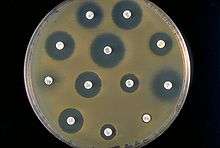Bacterial lawn

Bacterial lawn is a term used by microbiologists to describe the appearance of bacterial colonies when all the individual colonies on a petri-dish agar plate merge to form a field or mat of bacteria. Bacterial lawns find use in screens for antibiotic resistance and bacteriophage titering.
Bacterial lawns (often of Serratia marcescens) are also used extensively when as an assay method when using bacteriophage as tracers in studies of groundwater flow.
Although occasionally used as a synonym for biofilm, the term primarily applies to the simple, clonal, unstructured mats of organisms that typically only form on laboratory growth media. Biofilms—the aggregated form of microorganisms most commonly found in nature— are generally more complex and diverse and marked by larger quantities of extracellular structural matrix relative to the cellular biomass.
Techniques
Bacterial lawns can be produced manually by evenly spreading a high amount of bacteria onto an agar plate using a sterile cotton swab. Alternatively an automated machine can be used such as a spiral plater where the plate is rotated and the sample is spread evenly using an automated dispenser.
References
- Madigan, Michael; Martinko, John, eds. (2005). Brock Biology of Microorganisms (11th ed.). Prentice Hall. ISBN 0-13-144329-1.